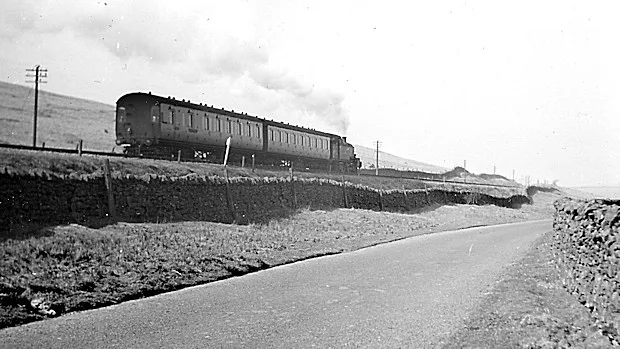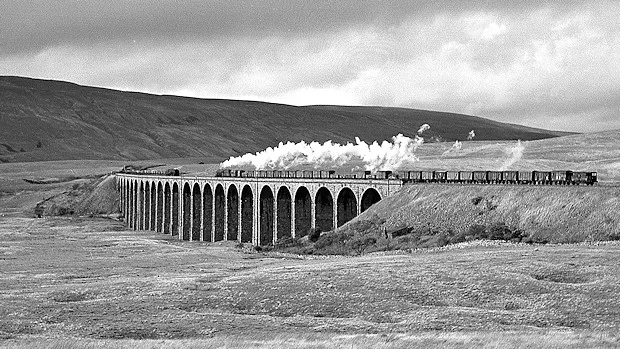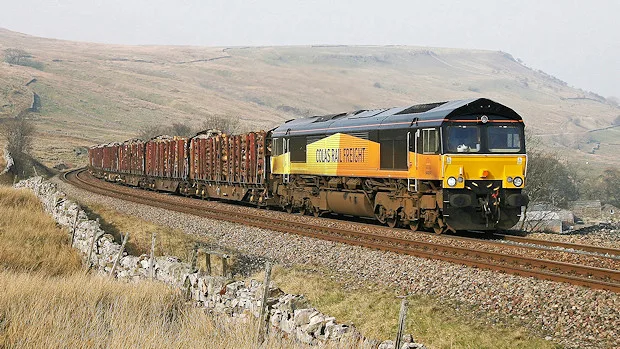Two of the one-time three great Anglo-Scottish main lines pass through Cumbria. Built at an interval of 30 years, both faced very different political and geographical problems in the promotion and construction.
Both take advantage of the favourable topography of the Vale of Eden in the east of the county between the mountains of the Lake District and the Northern Pennines, but have to tackle the upland barrier to the south in very different ways.
Both are outstanding examples of Victorian engineering skills.
Lancaster and Carlisle line
Now part of the West Coast Main Line, the Lancaster and Carlisle Railway (L&CR) was constructed in the mid-1840s as part of the completion of the railway link northwards from Lancaster to Edinburgh and Glasgow, only after a prolonged debate, and a Royal Commission, examining the relative merits of going round the Cumbrian coast or more direct route over Shap Fell with its heavy gradients. With the final decision to go for the latter, and being first on the scene, “The Lanky”, as it is still known among older railwaymen in Carlisle, would have been able to take advantage of the easier route from Lancaster up the Lune Valley before tackling Shap Fell with its summit of 916 feet above sea level. However, this obvious course was to be altered as a result of pressure for access to the railway by the inhabitants of Kendal, a measure which involved a secondary climb to Grayrigg as a result of having to cross from the valley of the River Kent to that of the River Lune before proceeding northwards.

The Lancaster and Carlisle Railway was opened through to Carlisle on 15th December 1846, 72 miles of railway having been completed in just over two years in the biggest railway construction contract yet awarded. Initially the line was operated by the London & North Western Railway (LNWR) but relations with its big partner to the south became more and more strained until the working agreement was terminated in 1855. Hurriedly gathering its own fleet of locomotives and rolling stock, the L&C successfully worked its own section of the West Coast route until 1859 when it was leased to the LNWR.
The route of the L&CR provided immense operating difficulties from the opening of the line until very recent years, with its steep climbs to Grayrigg and Shap summits. From only a few feet above sea level at Hest Bank, near Carnforth, the line climbs to nearly 500 feet at Grayrigg, the last two miles being at a gradient of 1 in 106. In steam days many heavy trains would take assistance from Oxenholme. After a level stretch through the Lune gorge to the junction and banking station of Tebay climbing begins in earnest up the four and a half miles at 1 in 75 to Shap Summit, 916 feet. The descent then includes seven miles of 1 in 125 to Penrith and four miles of 1 in131 down to Carlisle, a formidable test for a steam locomotive and its crew setting off from cold for the south.
Faced with such operating difficulties the line has always been real challenge to locomotive engineers, their response culminating in the Princess Coronation Pacific locomotives designed by Sir William Stanier in the mid-1930s. They worked most of the principal trains over the line until displaced by diesels from 1960. With the end of steam the need for banking assistance became less necessary and engine sheds at Tebay and Oxenholme closed.

Electrification of the West Coast Main Line was completed through to Glasgow in May 1974, transforming operation of the route, even after several years of diesel double-heading on the top express trains. Start to stop times between Preston and Carlisle (90 miles) have been reduced from the fastest steam time of 101 minutes in 1939 to 94 in 1972 with diesel haulage and 72 minutes in 1979 with the then new Class 87 electric locos. Currently (late 2008) timings of 58 minutes are being achieved by Virgin’s Pendolino tilting trains.
Openings and Closures
Notes: Opening dates are all for passenger traffic; goods traffic may have been worked from an earlier date. Not all stations were opened with the original opening of the line and some stations may have been moved from their original locations.
| Line | Opened | Closed |
| Lancaster to Kendal Junction (Oxenholme) | 22 September 1846 | Open |
| Kendal Junction to Carlisle London Road | 17 December 1846 | Open |
| Station ( South to North ) | Opened | Closed |
| Lancaster Castle | 22 September 1846 | Open |
| Hest Bank | 22 September 1846 | 3 February 1969 |
| Bolton-le-Sands | 22 September 1846 | 3 February 1969 |
| Carnforth – main line platforms | 22 September 1846 | 4th May 1970 |
| Burton & Holme | 22 September 1846 | 27 March 1950 |
| Milnthorpe | 22 September 1846 | 1 July 1968 |
| Oxenholme | 22 September 1846 | Open |
| Grayrigg | 22 September 1846 | 1 February 1954 |
| Low Gill | 22 September 1846 | 7 March 1960 |
| Tebay | 22 September 1846 | 1 July 1968 |
| Shap | 22 September 1846 | 1 July 1968 |
| Clifton & Lowther | 22 September 1846 | 4 July1938 |
| Penrith | 22 September 1846 | Open |
| Plumpton | 22 September 1846 | 31 May 1948 |
| Calthwaite | 22 September 1846 | 7 April 1952 |
| Southwaite | 22 September 1846 | 7 April 1952 |
| Wreay | 22 September 1846 | 16 August 1943 |
| Brisco | 22 September 1846 | December 1852 |
| Carlisle Citadel | 22 September 1846 | Open |
Windermere Branch
The Kendal and Windermere Railway began as a local enterprise to provide a connection with the Lancaster and Carlisle Railway at Oxenholme, two miles away from Kendal on the fell to the east. It was promoted and built at the same time as the main line, being completed through to Windermere on 20th April 1847. It was leased to its bigger neighbour in 1859, passing almost immediately to the LNWR. Although it still has through services to Manchester it is a shadow of its former self, but remains as the only branch line into the Lake District – and is still important for the rail-borne tourists it brings into the area.

Openings and Closures
| Line | Opened | Closed |
| Kendal Junction (Oxenholme) to Kendal | 22 September 1846 | Open |
| Kendal to Windermere | 21 April 1847 | Open |
| Station | Opened | Closed |
| Kendal | 22 September 1846 | Open |
| Burneside | 21 April 1847 | Open |
| Staveley | 21 April 1847 | Open |
| Windermere | 21 April 1847 | Open |
Further reading: The Kendal and Windermere Railway, by Dick Smith (Cumbrian Railways Association 2022)
Low Gill and Ingleton
During the 1840s the North Western Railway was promoting and building its main line from Skipton towards Lancaster and conceived the idea of a line up the Lune valley to join the Lancaster & Carlisle Railway at Low Gill, thus providing an outlet towards Scotland from West Yorkshire. Eventually the impecunious company had to abandon construction beyond Ingleton and reached agreement with the Lancaster and Carlisle Railway to complete the section south from Low Gill to make an end on connection just north of Ingleton. However, inter-company rivalry ensured that this line was never to effectively operate as a through route. Obstructionist tactics were designed to deter passengers, with few trains running over the viaduct at Ingleton and these not making sensible connections. This did not improve once both lines had been taken over by much larger companies, the L&CR by the London & North Western, and the North Western by the Midland Railway in 1859. Nevertheless, in the early 1860s the line was envisaged by the Midland as having the potential to provide its own through route to Scotland via the L&CR over Shap, but was eventually forced to build the Settle & Carlisle line instead.

The line became a rural branch line and was never to function as a trunk route except when diversions from the Settle and Carlisle line were necessary. Passenger services were withdrawn in 1954 with complete closure following ten years later.
Openings and Closures
| Line | Opened | Closed |
| Low Gill to Clapham | 16 September 1861 | 26 July 1966 |
| Station | Opened | Closed |
| Low Gill (see L & C) | 22 September 1846 | 7 March 1960 |
| Sedbergh | 16 September 1861 | 1 February 1954 |
| Middleton-on-Lune | 16 September 1861 | 30 April 1931 |
| Barbon | 16 September 1861 | 1 February 1954 |
| Kirkby Lonsdale | 16 September 1861 | 1 February 1954 |
| Ingleton (L&NWR) | 16 September 1861 | 1 January 1917 |
| Ingleton (Midland) | 1 October 1861 | 1 February 1954 |
| Clapham | 30 July 1849 | Open |
Further reading: The Ingleton Branch, A Lost Route to Scotland, by Robert Western (The Oakwood Press,1990)
The Settle and Carlisle Line
During the 1860s the Midland Railway was expanding from a purely regional concern into a trunk line of national importance. Having planned its London Extension (completed to St.Pancras in 1868) it turned its attention to opening up a third main line to Scotland via the East Midlands and West Yorkshire. First it sought facilities for its traffic over the L&CR line via Ingleton, but met with stubborn resistance from the LNWR. It therefore sought a line of its own to Carlisle, surveying and, in 1866, obtaining powers for the Settle and Carlisle Railway. The LNWR position then softened, and negotiations with the Midland led to an agreement allowing the Midland access over Shap to Carlisle. Then seeking powers to abandon its Settle and Carlisle commitment it faced very strong opposition from its railway allies and local communities, losing the Abandonment Bill in 1969. So began the massive task of constructing 72 miles of railway through some of the most inhospitable and remote country in England, and only after immense difficulties was it eventually to be completed and opened to passengers on 1st May 1876.

From Settle Junction, where the new line left the existing North Western line, the Settle and Carlisle climbs up Ribblesdale for 15 miles at a gradient of 1 in 100. Blea Moor Tunnel takes the line under the shoulder of Whernside into Dentdale with an easy high level section through Rise Hill Tunnel into Garsdale and the summit of the line at Ais Gill, 1169 feet above sea level. Thence the line follows the valley of the River Eden down to Carlisle, the first 15 miles down again being predominantly at 1 in 100.
Over this route the Midland Railway pioneered a high standard of passenger comfort and service, in conjunction with its Scottish partners, the Glasgow & South Western Railway (GSWR) and the North British (NBR). However, from 1923, when both the LNWR and Midland were merged into the London Midland & Scottish Railway (LMS), the route over Shap has had priority for new investment. The Settle and Carlisle lost its Anglo-Scottish expresses in 1982 and the line was put up for closure. After an epic battle of people versus the establishment the line was granted a reprieve in 1989 and has since become a key route for rapidly growing freight traffic between England and Scotland, and probably carrying more passengers than even before!

Openings and Closures
| Line | Opened | Closed |
| Settle Junction to Carlisle | 1 May 1876 | Open |
| Station | Opened | Closed |
| Settle Junction | 1 May 1876 | 1 November 1877 |
| Settle | 1 May 1876 | Open |
| Horton-in-Ribblesdale | 1 May 1876 | 4 May 1970 |
| reopened | 14 July 1986 | Open |
| Ribblehead | 1 May 1876 | 4 May 1970 |
| reopened | 14 July 1986 up platform only | Open |
| reopened | 28 April 1993 new down platform | Open |
| Dent | 1 May 1876 | 4 May 1970 |
| reopened | 14 July 1986 | Open |
| Garsdale | 1 May 1876 | 4 May 1970 |
| reopened | 14 July 1986 | Open |
| Kirkby Stephen | 1 May 1876 | 4 May 1970 |
| reopened | 14 July 1986 | Open |
| Crosby Garrett | 1 May 1876 | 6 October 1952 |
| Ormside | 1 May 1876 | 2 June 1952 |
| Appleby | 1 May 1876 | Open |
| Long Marton | 1 May 1876 | 4 May 1970 |
| Newbiggin | 1 May 1876 | 4 May 1970 |
| Culgaith | 1 May 1876 | 4 May 1970 |
| Langwathby | 1 May 1876 | 4 May 1970 |
| reopened | 14 July 1986 | Open |
| Little Salkeld | 1 May 1876 | 4 May 1970 |
| Lazonby & Kirkoswald | 1 May 1876 | 4 May 1970 |
| reopened | 14 July 1986 | Open |
| Armathwaite | 1 May 1876 | 4 May 1970 |
| reopened | 14 July 1986 | Open |
| Cotehill | 1 May 1876 | 7 April 1952 |
| Cumwhinton | 1 May 1876 | 5 November 1956 |
| Scotby | 1 May 1876 | 1 February 1942 |
Further reading:
North of Leeds, The Leeds-Settle-Carlisle Line and its Branches, by Peter E. Baughan
(Roundhouse Books, 1966 and later)
The Line that Refused to Die, by Stan Abbott and Alan Whitehouse (Leading Edge, 1990; revised edition 1994)
Also see Bibliography.